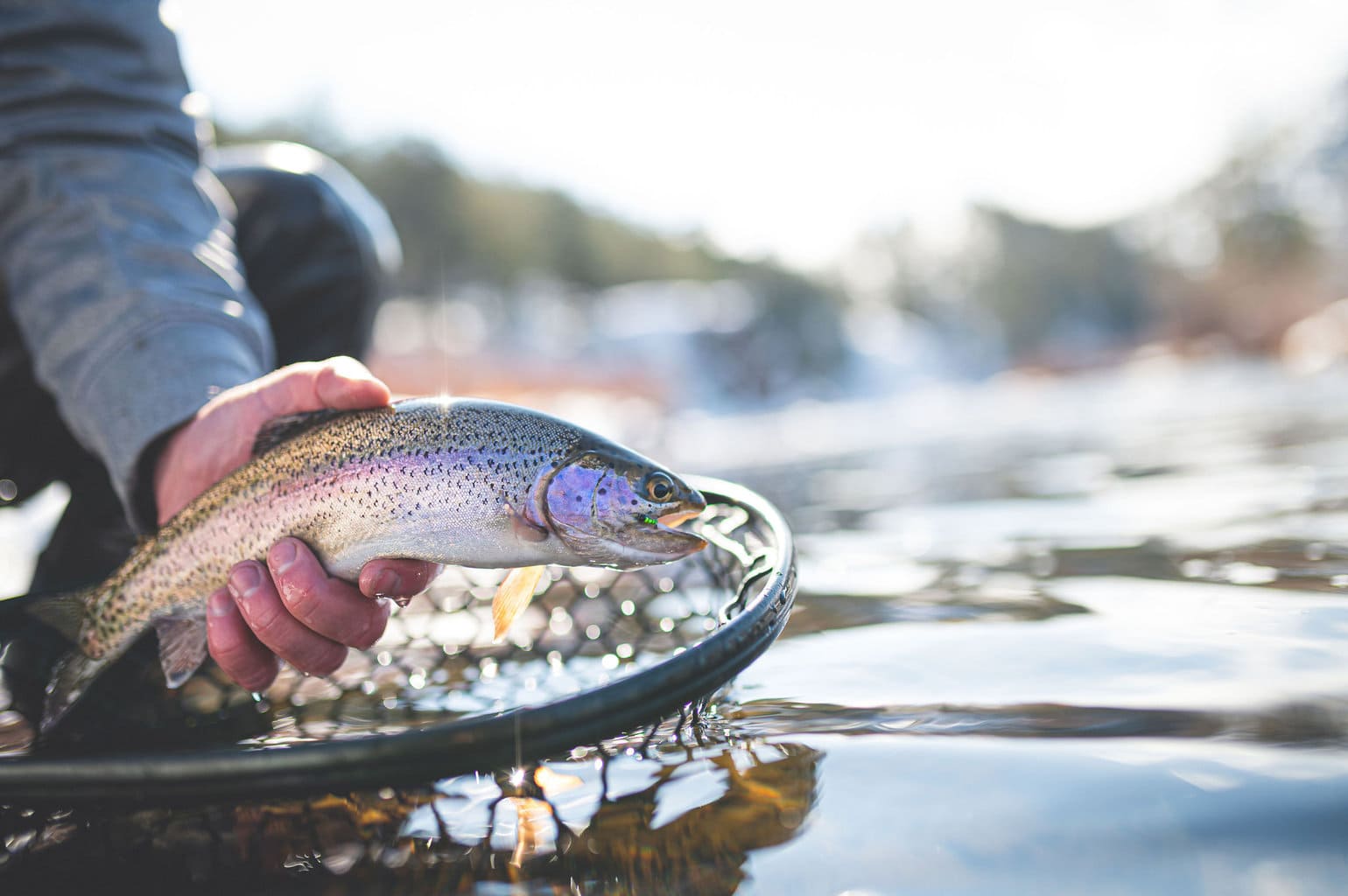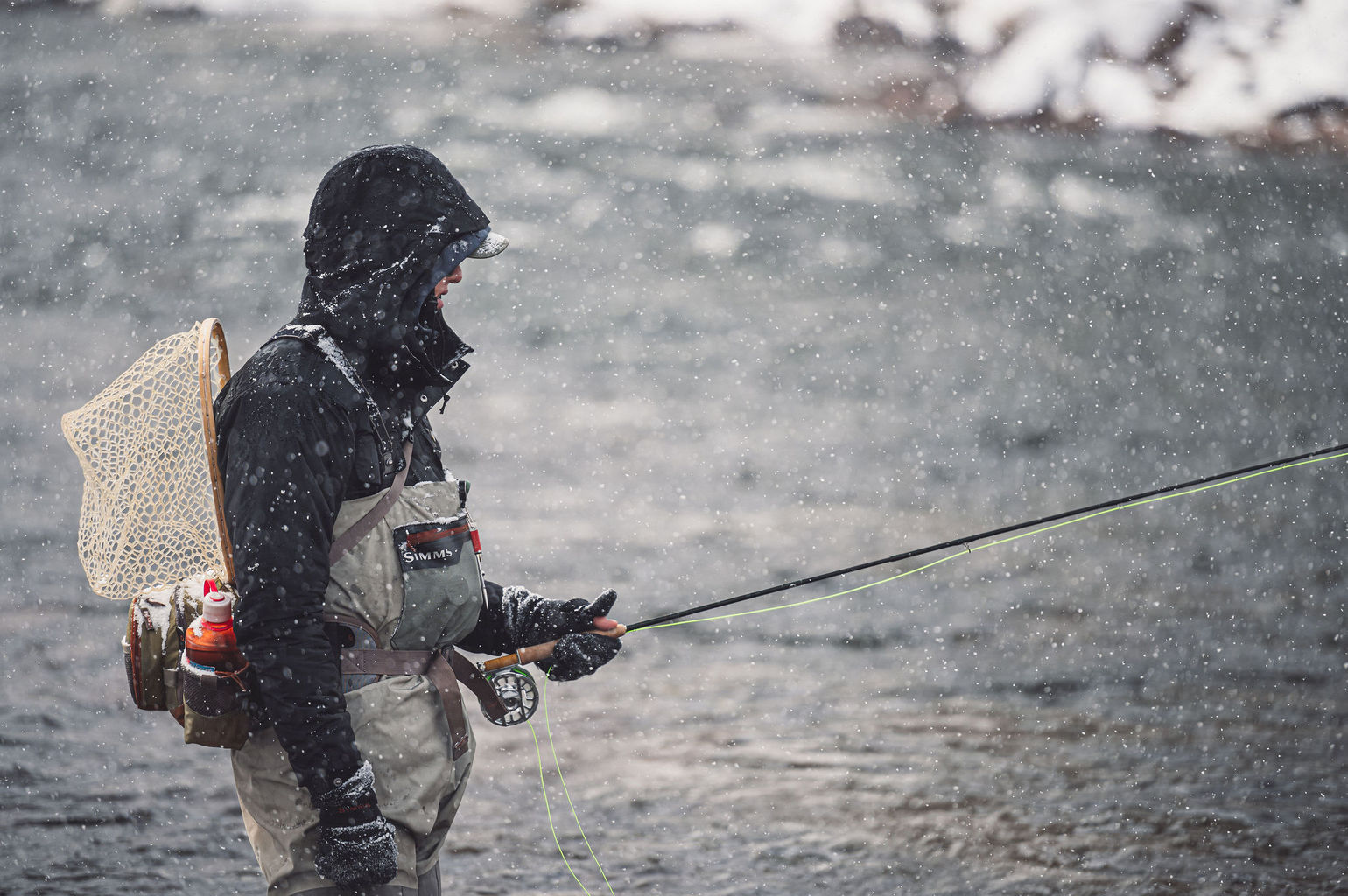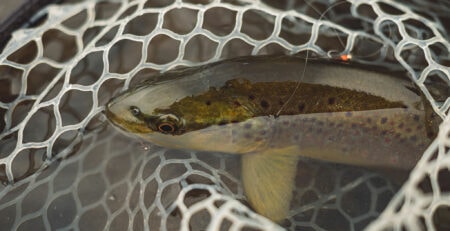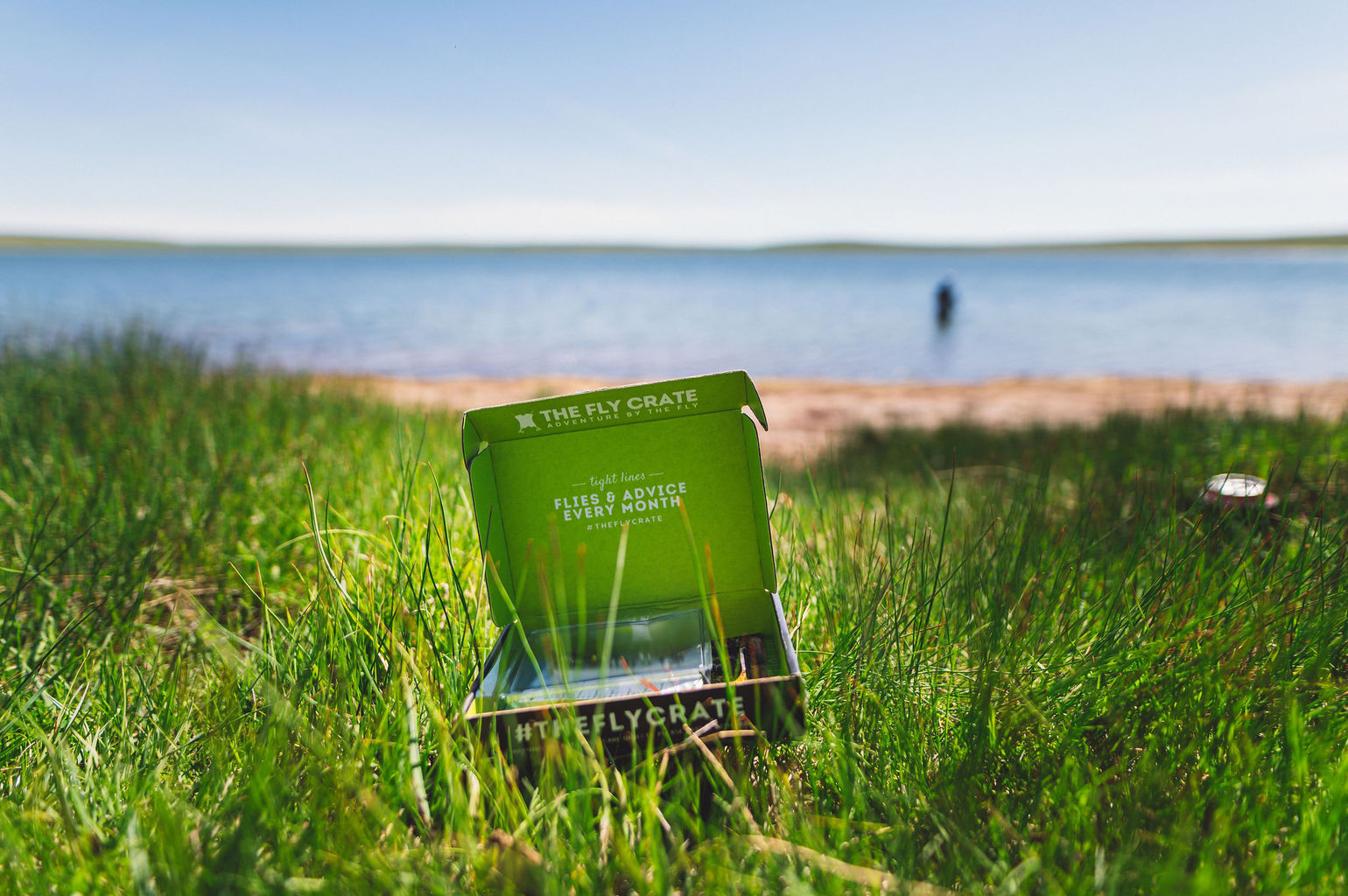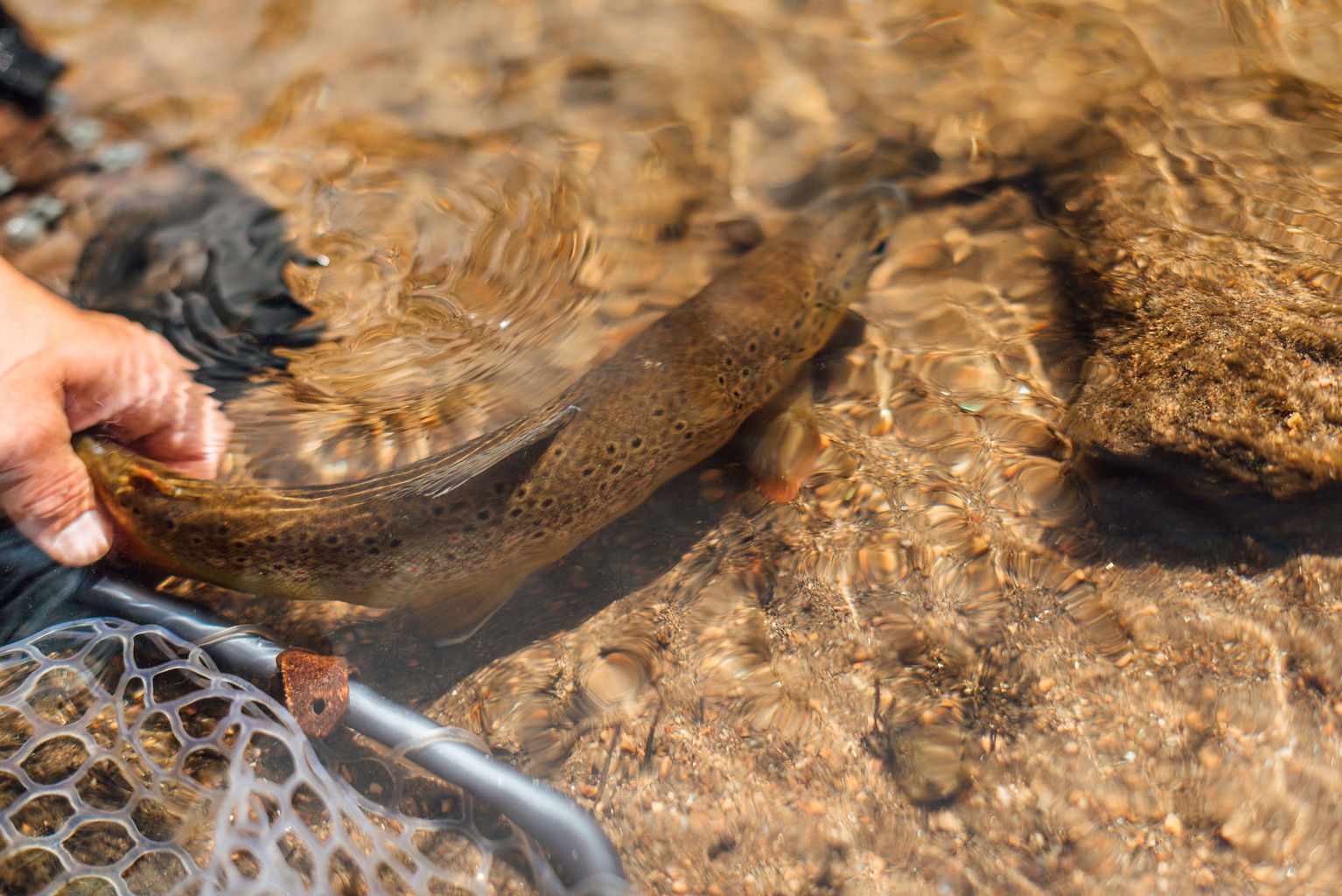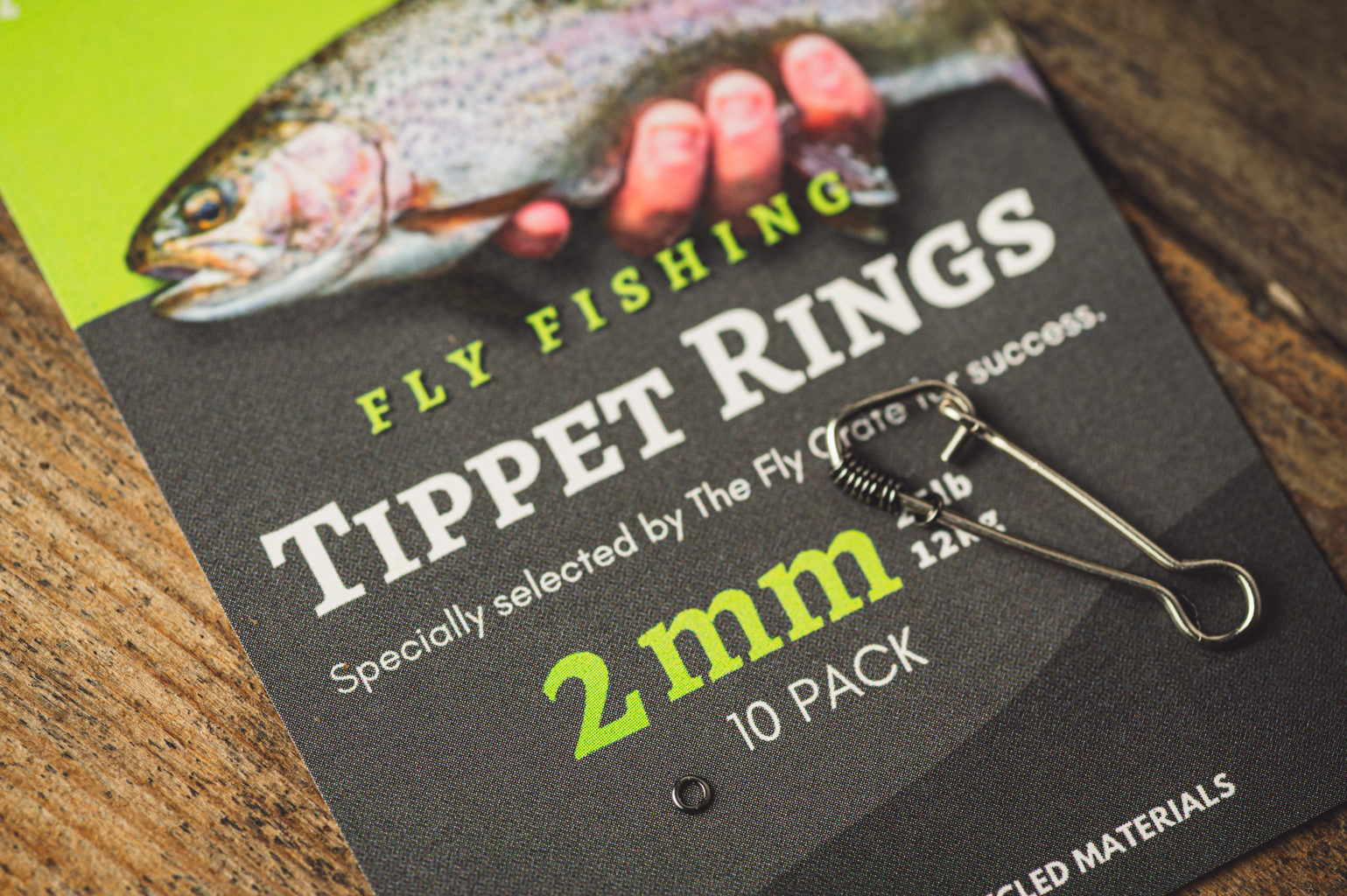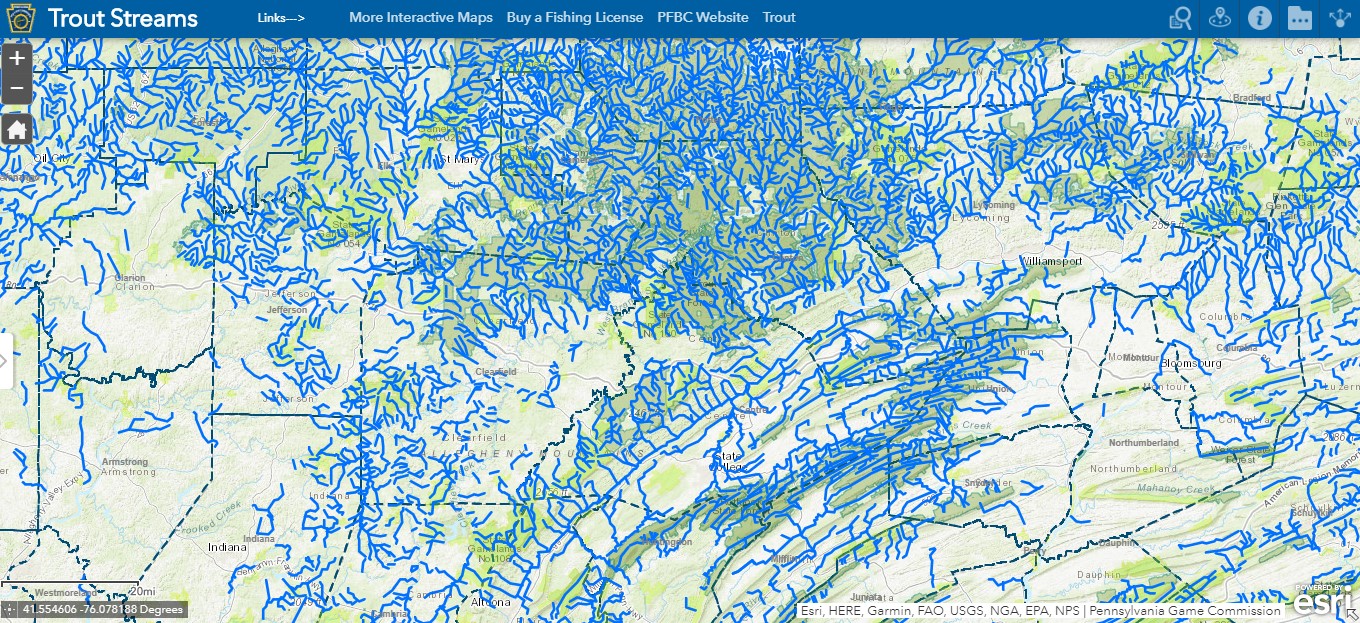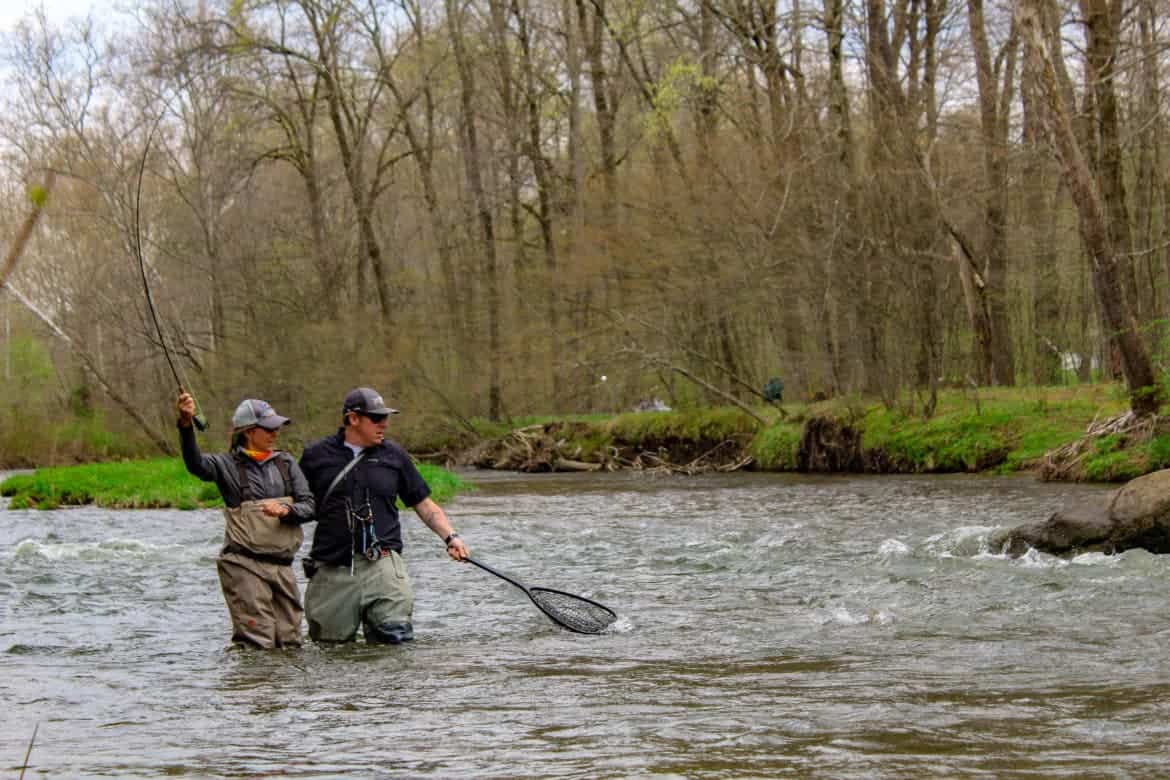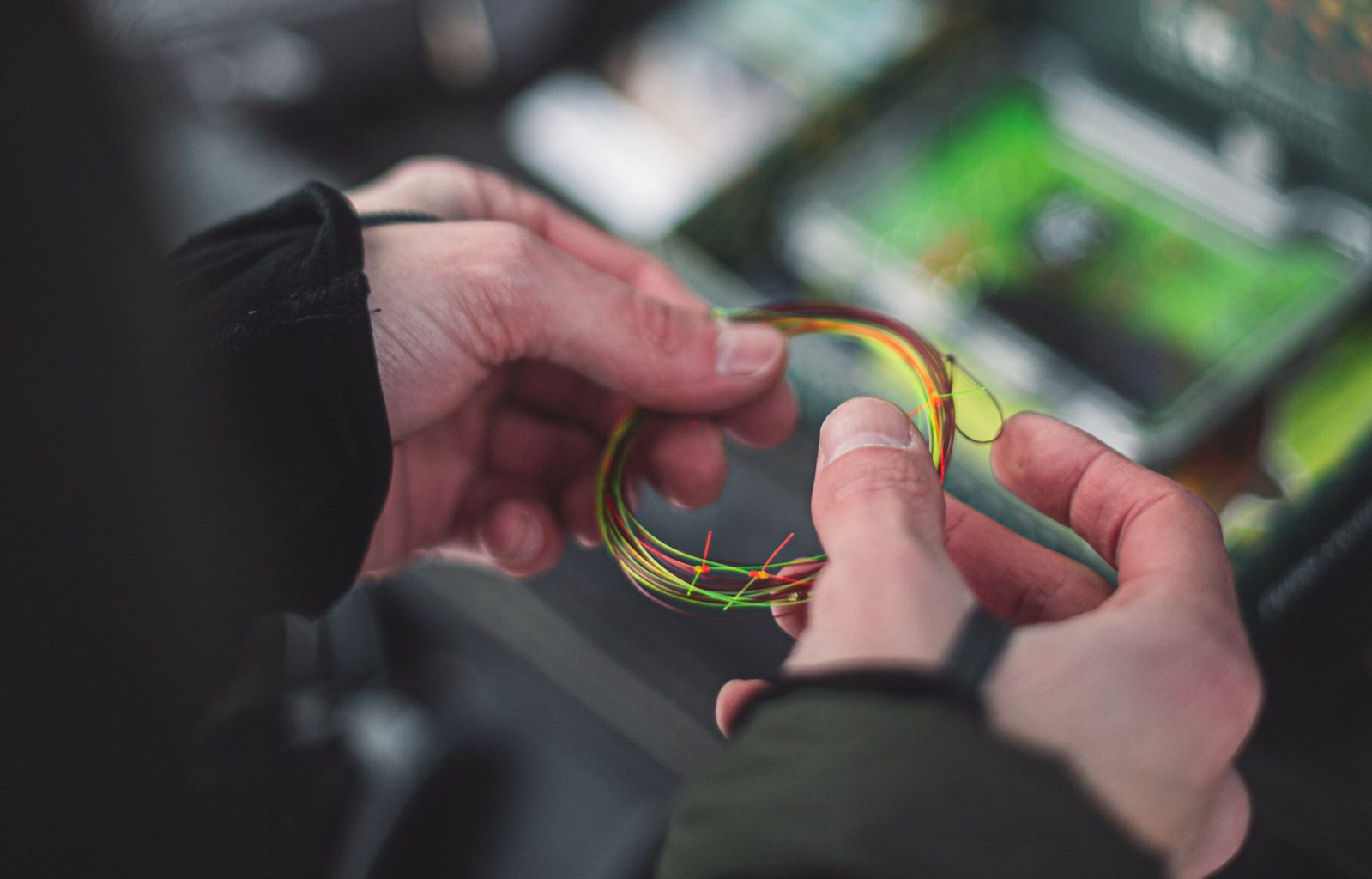How To Fly Fish in March and Early Spring Time
A Guide to Fly Fishing The Spring Fishing Season
Springtime is an exciting time of the year for anglers. Huddled over our fly tying vice, or rereading The Drake Magazine in our living rooms all winter can become very mundane tasks. Replaying last season’s memories of rising trout eagerly eating dry flies on our favorite river over and over. Fly fishing in March ushers in rising temperatures, which means trout start their spring spawning runs. After a long winter, rivers come into fishing form and insect hatches are in their beginning stages. Opportunities abound for excellent fly fishing before the summer months arrive. Fly fishing in spring brings many challenges to anglers: dissecting the different hatches, fishing runoff, and high water levels, and figuring out all the great fishing that area lakes have to offer. We are going to give you some tips and tricks on how to fly fish in March and ways to approach spring fishing scenarios.
Table Of Contents
- Where To Find Fish in The Spring
- What Flies Should I Use For March Fly Fishing
- How to Fly Fish Pre Runoff and Post Runoff
- How to Fly Fish Lakes in The Spring
Other Spring Fly Fishing Articles:
- The 15 Best Trout Flies For Spring Fly Fishing That Actually Catch Fish
- 5 Spring Fly Fishing Tactics and Flies
If you are part of the animal kingdom, spring is an exciting time. Most animals tend to go into some sort of hibernation or lethargic state during the winter months. Doing their best to conserve energy and make it through the toughest time of the year. Food is scarce and temperatures are cold. As warmer spring temperatures arrive, this is a signal in the animal kingdom that is time to wake up and start their reproductive life cycle.
Where To Find Fish in The Spring

Winter trout fishing is characterized by fishing smaller flies in cold weather. Winter trout are usually found in the deepest slowest parts of the river and places that offer areas of shelter from predators. The water is rich with oxygen, and trout go into a lethargic state. Safety and survival are their motivating factors.
Water levels are usually at their lowest in the winter months, so trout are concentrated in deep pools. Fish are less active and catching trout can be difficult depending on the time of the day. A trout’s diet is limited as food is scarce because one of the only insect hatches is midges. Trout tend to survive from a balanced diet of midges, mayfly and stonefly nymphs, scuds, worms, eggs, and baitfish.
Trout in the winter, tend to stay in the same place. In most cases, they tend to migrate to the same winter-holding pools and run year after year. Deep pools with fallen trees, large boulders, shelves, root systems, or aquatic vegetation are all great places for trout to take refuge. They feel most comfortable in places where shelter from predators is only a few feet away. But, you’ll still find trout feeding in faster riffles at the front and tail of the pool.
The warmer temperatures in March, signal to trout that it is time to prepare for the spawn. This sets the stage for great fishing and is the official kick off the spring fishing season.
When considering spring time fishing and where to find trout. Anglers need to remember the motivating factor in where fish live and eat is primarily motivated by the urge to reproduce. Trout are salmonids. This means that a trout takes the same path that other salmonids take in the early spring when the spawning season starts.

An andramonous fish’s lifecycle (fish that migrate up rivers and streams to spawn) is straightforward: hatch, migrate, spawn, die. In the case of rainbow trout, they do not die in the same manner as sockeye salmon or silver salmon once they lay their eggs. They return back to the lake or their prime lie in the larger river system. For anglers, this means in the spring, they should focus on feeder streams to lakes, or tributary creeks to larger bodies of water. Spring time is a great bet for anglers to find big fish in shallow water.
No matter what fishery you are fishing, trout need clean gravel free of weed beds to lay their eggs. Unlike winter, warmer temperatures create active spring trout. Fish will be found in more typical summer lies than in the cold winter months. They will move from deep pools to shallow areas of the river. The reward for a high calorie meal makes it worth moving out of the safety of deep pools to consume a meal. Bouldery pocket water, riffles, runs, and deep buckets should all be fished.
Watch The Spring Weather
Whatever fishery you are fishing, March weather plays a major role in nudging fish out of their lethargic winter state. Keep an eye out for consecutive days with warmer weather. Rain can also warm the water up and create fishing opportunities. Midge, larger mayflies, and baetis hatches will begin to find their rhythm. The added food source of blue winged olives with winter midge hatches will wake the trout out of their winter slumber and motivate them to move into shallow water.
Wade Fishing and Redds
This time of year, it is important to watch where you step when wade fishing for trout. Rainbow trout spawn in the spring and they use there tails to create sediment free nesting areas called “redds”. You can spot these redds in the stream bed because it is clear that the gravel has been cleared of sediment. Need help spotting them? Here’s an in-depth look at fish redds. Trout lay an orange blob of eggs in the cleared gravel. If fishermen walk through the nesting areas while wade fishing, it will kill and destroy the eggs, and is detrimental to fish populations.
What Flies Should I Use For March Fly Fishing?

Think small and light for March fishing situations. Midges hatch year round and are the main food source trout eat during the long winter months. Typically in March, warming water and air temperatures usher in new insect hatches. Baetis mayflies start to hatch. Certain western states feature the famed Skwala Stoneflies, while most streams host March Browns, Caddis Flies, Quill Gordons, and Blue Winged Olives (BWOs). All of these add a new food source to a trout diet, and these hatches become more prolific as the month of March ushers in more consistently warm weather and balmy days. Dry fly fishing opportunities become more abundant, and the surface of the river is dotted with rising trout during the afternoons.
The March Mayflies and B.W.O Lifecycle
Blue winged olives have your standard mayfly life cycle: eggs, nymph, adult, and spinners. Found in the gravel bottom of stream beds and slower runs, the nymphs live underneath river rocks. B.W.O.’s are tiny mayflies and they hatch most of the year, but their peak months to emerge are March through May until the late summer and fall hatch. When the light and temperature of the water reach the optimal point, they crawl out from underneath rocks and swim to the surface of the water to emerge through the meniscus. They become adults, fly to the streamside bushes to mate, and return to the water’s surface to die as mayfly spinners.
B.W.O. Strategies
Blue winged olive nymphs are active swimmers and are known to move short distances in the river. It is a great bet that trout will feed on these nymphs even when there is no active hatch happening. While dead drifting nymphs are effective, fish will eat flies swinging through the water current. Other nymph fishing techniques like the Leisingenring lift can be effective. Especially in pre-hatch situations, where trout are keyed into nymphs swimming to the surface.
The Leisenring lift involves using a floating line and casting your flies upstream, letting the flies sink deep to the bottom of the stream, fishing the flies on a dead drift, and then as they pass you raising your rod tip and slowly bring the flies up through the water column imitating a nymph swimming to the surface. This is an effective fly fishing technique for catching trout during a variety of hatches.
Although midges provide dry fly fishing opportunities in the winter, the bulk of the mayfly hatches will tend to draw the most fish to the surface. Caddis flies, a moth-like insect, can hatch as early as March in a variety of colors ranging from black to a speckled brown or tan. B.W.O.’s can range from light grey to dark olive in color while March Browns and Quill Gordons can be a light brown to light grey color.
It is important when dry fly fishing to look closely at hatching insects and the rise forms that trout are creating on the surface.
Recommended Reading: How To Match The Hatch Based on Trout Feeding Behaviors
Trout will key into specific life phases of the hatch, and often times dry fly fishing will leave anglers scratching their head wondering why rising trout are eating everything but your dry fly. There are usually two reasons for this:
1. your fly is not specifically matching the insects that are hatching: size, shape, color, etc., or 2. rising trout appear to be eating the adult mayflies, but are actually eating emergers just under the surface. It can be difficult to untangle the puzzle of selective rainbow or brown trout.

Choose the right fly first. B.W.O.’ range from size #16-20, so make sure you are fishing a small fly matched specifically to the size of insects on the water. Also, typically B.W.O.’s are different colors on top then they are on the bottom of their bodies, choose a dry fly color that matches the underside of the real insect. After all, trout don’t see the top’s of dry flies. You can never go wrong fishing with a small parachute Adams. Carry permanent markers in your vest. This allows you to make color changes on the water. If your fly box contains wide array of parachute Adams in various sizes in the color grey, with permanent markers, you can cover almost any hatch situation when in a bind. B.W.O. Thorax duns are also a great match the hatch patterns that sit low in the water. Covering both adult and emerger stages of the hatch.
Feeding Trout Eating Cripples and Emergers

If you are throwing an Adam’s or true dry fly and are not able to catch fish, then try a cripple or emerger pattern tied behind your dry fly on 18-24″ inches of tippet. Mayflies often get stuck in the meniscus of the surface water during their emergence as adults. Oftentimes, insects spend a long time and a lot of energy forcing their way through the surface film. Mayflies that get stuck in their shuck and cannot fully emerge through the meniscus are called cripples. Trout see cripples as an opportunity to feed themselves without having to spend much energy doing it.
Even if they don’t get caught in the meniscus, the time it takes for insects to emerge can be long. Emergers are extremely vulnerable and give trout easy access to a meal. When trout fishing, you can tell if rising trout are eating emergers or adults by the rise form on the surface of the water. If a trout takes an adult mayfly or insect you will be able to see it open it’s mouth and eat the bug. If you are seeing rising trout on the surface, but all you see is fish porpoising, they are eating emergers in or under the surface film. Fish an emerger pattern on a floating line. Emerger flies that hang in the surface film, usually, ones with a curved hook (klinkhammers, foam para emergers, foam RS2 emergers) are a great bet when trying to catch selective rainbows and weary brown trout.
Recommended Reading: Dry-Dropper Nymph Tactic For Selective Trout
Another option that works well, is to fish a dry fly with a small unweighted nymph tied 18-24″ off of it. Grease the tippet and put dry fly floatant on the unweighted nymph. Selective trout that don’t feed on the dry fly will usually take the unweighted nymph fished just under the surface of the water. The Frog’s Fanny allows the fly unweighted fly to sit in the surface film. It also creates air bubbles around the fly and it is absolutely deadly in terms of tricking selective fish.
Fishing the March Brown Hatch

As spring continues to bring warming weather, the first hatch of larger mayflies occur with the March brown hatch. Depending on where you are, there are both Eastern and Western March Brown hatches. In the West, March browns typically hatch in late March and early April. On the Eastern seaboard, March Browns start later in spring. May and June are the typical months in the eastern part of the U.S.
These are larger may flies that range in size from #12-14. Despite being named brown, they can range in color from grey to dark brown. March browns will move from faster moving water to slower areas to hatch. Like most mayflies, they have to swim to the surface of the river and break through the meniscus. March brown’s spend an extremely long time in the surface film, many times they meet their demise caught in the meniscus. Flies fished with a floating line just under the surface of the river can yield big fish that feed on the emerger stage of the March brown hatch.
March browns hatch sporadically. While they are on the water don’t overlook the smaller insects like B.W.O.’s and midges. That being said, they are a large meal, and prospecting with a Hare’s ear or large dry fly can produce great results. March Browns typically hatch in the afternoons, so nymphs fished deep, or focusing on other hatches during the earlier parts of day is a good strategy until you see March brown activity. Just like B.W.O.’s cloudy days are ideal. While clouds can slow down other hatches like stoneflies, balmy cloudy days get March browns going. This can bring big fish to surface in large numbers and create epic dry fly fishing opportunities.
How to Fly Fish Pre Runoff and Post Runoff

Spring fishing can be broken into two parts, pre runoff and runoff. As we mentioned above, warmer temperatures create the opportunity for more hatches and an abundance of food sources in the water. This also triggers spring runoff. Spring runoff is when the increased snow melt from the warmer temperatures floods the river and water levels rise. Often time this causes rivers to be “blown out”. This means that the water is dirty and unfishable. Although this makes fly fishing more difficult. It is a necessary part of a river’s life cycle and is good for fishing in the long run. There are still plenty of fly fishing opportunities.
How to Fish Spring Runoff For Trout
When spring runoff happens, this can trigger some of the best fishing of the year, especially for big fish. In my experience, I tend to not catch as many fish in the spring as in summer because the water is still very cold, but some of the biggest fish of the year are often caught during the spring.
Worms, Eggs and High Water Levels

First and foremost, rainbows start their spawn when the water temperature reaches the upper 40’s degrees Fahrenheit. This can happen anywhere from February to April. Warm spring rains and runoff bring the water temperature up too. After a long winter of eating midges, an orange blob of eggs floating down the bottom of the river is an easy meal for trout that have been lethargic in the winter.
In addition, as the water rises on river banks, worms that are normally out of reach from feeding fish are pushed into the river from eroding streamside banks. Big flies fished deep under a strike indicator can produce big fish. Fishing worms and egg flies is a lot of fun and this signals that fishing season has really started, big flies fished on big water. My standard rig this time of year is a two fly rig fished on 3x tippet under a strike indicator. I always add a good amount of split shot to get the flies down to the fish.
Here are some of my favorite trout flies for February, March, and April.

Photo Courtsey of FishUSA

I also recommend trying leach patterns as your point fly, or event a large size 4 Pat’s rubber leg. Depending on the situation, I’ll even nymph double rubber legs which can be extremely effective.
Stoneflies

As March gives way to April, May, and June, on many rivers we start to see various types of stoneflies hatch. Skwala stone flies, golden stones, and salmon flies all bring big meals to feeding fish. Whether you are wade fishing or float fishing, to many fly fishermen these hatches are the pinnacle of the sport of fly fishing.
StoneFly Life Cycle


Stoneflies are crawlers, unlike mayfly species that swim to the surface, stoneflies migrate to the river’s edge and crawl out onto the river rocks and bushes. Many times you can see their exoskeletal shucks on river bridges, rocks, docks, or streamside vegetation. They come in many different sizes, but we are focusing on the larger spring time species. They range in size from #12-#2 depending on the species. These are huge meals and offer easy access to feeding trout. When this time of the year, trout will gorge themselves on bugs. It is not uncommon to have thousands of salmon flies on the water, but not be able to catch any fish. It can take a few days for trout to adjust there diet to the shear amount of food in the fishery.
As stoneflies grow, they take over larger areas of habitat. This is called behavioral drift. Stoneflies migrate to other parts of the river. This usually happens early in the morning or late in the evening. When they crawl out from under the rocks and hit the water current, they tumble along the river bottom in the current. This is the time you want to have plenty of Pat’s rubber legs in various colors and sizes. In my home fishery the South Fork of the Snake River, my personal favorite is a Pat’s rubber leg in orange and black in size #6 double heavy. Fished deep under a strike indicator, the flies are bounced along the bottom of the river with a dead drift under a strike indicator. Spring time is the time of the year nymphing flies deep off of river shelfs and along river banks can be a very effective fly fishing method for catching big fish.
As the water temperature approaches 55 degrees. This is the signal to the stoneflies that it is time to migrate to the banks in preparation for the hatch. For a time period of roughly two weeks prior to hatching, stoneflies move to the river banks to stage for the coming emergence. The fish follow them. When the water temperature reaches 55 degrees, they crawl out of the water and into the bushes to hatch and grow their wings. This time of year anglers should focus on fishing the river banks. As a general rule of thumb, if you aren’t losing flies in the stream side bushes, then you aren’t fishing close enough. In fact, be prepared to lose a lot of flies, but that’s just part of fly fishing the skwala, salmon fly, and golden stonefly hatches.
Fishing Single Foam Flies
Fishing a single foam fly on a floating line on your favorite river is what every angler dreams about. This time of year, the dry fly fishing can be epic as most fish are looking up and concentrated in specific places. Trout instinctively know that this is their chance to get a days worth of calories in one meal. Dry dropper rigs work very well during the stonefly hatch, and fish are often caught by swing stonefly nymph patterns under over hanging bushes. Besides Pat’s rubber legs, I would recommend foam patterns in various sizes: stimulators, chubby Chernobyl’s, and rubber legged stimulators will all work well.
How to Fly Fish Lakes in The Spring

Although we have mostly talked about fly fishing rivers so far, don’t forget about some amazing spring time lake fishing too. In lower altitude lakes, ice off in March, April, and May can bring some of the best still water fishing of the year. Trout living under ice all winter long are ravenous when ice off occurs. Chironomids, which are midges, make easy targets for brook trout, brown trout and rainbows eager for a meal after a long winter. In high alpine lakes, you might not see ice off until July or August.
Chironomid Fishing after Ice off
Chironomids go through a complete metamorphosis: egg, larval stage, pupa, and adult. They can be found anywhere in the lake, even in water depths of up to 100 feet. The larva burrows themselves into the lake floor, and when they are ready to hatch, the pupa comes out of the lake’s substrate and slowly swims to the surface. To help them to the surface of the lake, they trap gases in between their pupal shuck and skin, giving them a shiny appearance.
Looking to learn more about chironomids? Here’s a great article by Fly Guys on chironomids and their lifecycle.
Fishing a chironomid hatch can sometimes be tricky because fishing at the correct depth is key to catching fish. Figuring out the correct depth can be the hardest part of the day. Chironomids are typically fished under an indicator and down deep just a foot or two off the bottom of the lake.
Streamer Fishing and the Figure Eight Retrieve

If lake fishing under an indicator is not your cup of tea, then fishing streamers on lakes is a productive method that provides increased action. Fish smaller streamers this time of year on both floating lines and sinking lines. Small rabbit fur leaches, semi seal leeches, unbalanced leeches, woolly buggers, and tungsten flash jig micro buggers will all do the trick. Make a long cast and let your fly sink to depth. A steady figure-eight retrieve will keep the fly down and provoke strikes. Unlike fishing streamers in rivers with long or erratic strips, a steady figure eight retrieve allows you to present the fly in a slow and uniform manner. A figure eight retrieve is when you slowly wind the fly line in with your line hand in a slow figure-eight motion. It keeps the line organized, and it allows you to stay in constant contact with the fly. This means you can detect almost every strike when lake fishing.
Fly Fishing Made Easy 👍
Our Quarterly Fly Club ships 1,000’s of flies to anglers all across the United States. Receive curated fly assortments selected for the season with in-depth articles on how to fish them. Great for beginners to learn and for intermediates to discover new flies.

